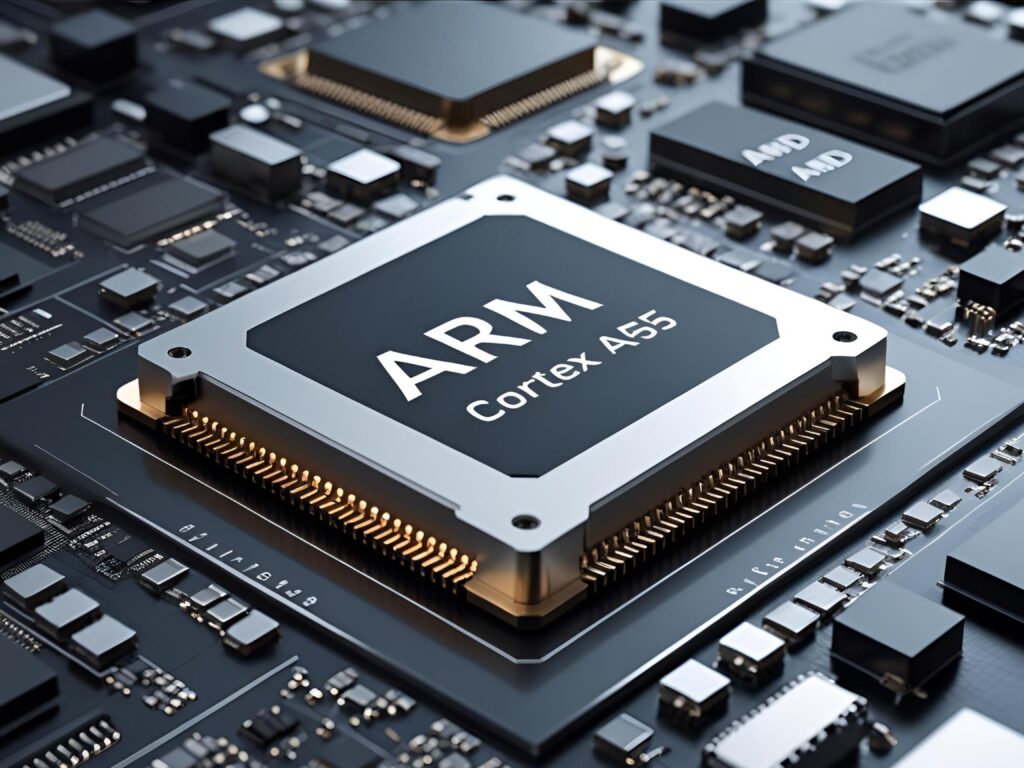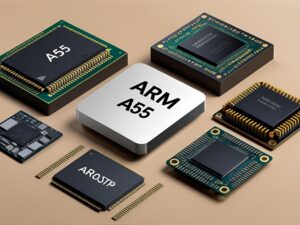INTRODUCTION
The Arm Cortex-A55 is a significant processor in the world of embedded systems and mobile devices, designed with a focus on energy efficiency and performance. As part of Arm’s Cortex-A series, it has become a go-to choice for manufacturers looking to balance power consumption with processing capabilities. But how does the Cortex-A55 compare to other processors in its class? This article delves into six crucial comparisons between the Cortex-A55 and other processors, highlighting its strengths and limitations.
6 Comparisons
Explore how the Arm Cortex-A55 stacks up against other popular processors in performance, efficiency, and real-world applications. These comparisons will help you understand where it excels and where it might fall short in embedded and IoT systems.
1. Performance: Cortex-A55 vs. Cortex-A53
The Cortex-A55 is often compared to its predecessor, the Cortex-A53, due to their shared focus on efficiency. The Cortex-A55, however, brings several enhancements over the A53, particularly in performance.
One of the key improvements is the A55’s higher instructions-per-clock (IPC) efficiency, which allows it to process more instructions within the same clock cycle compared to the A53. This results in a 15-18% performance uplift, making the A55 a better choice for applications requiring moderate processing power. Additionally, the Cortex-A55 features a more advanced memory system, including improved memory latency and bandwidth, contributing to overall better system performance.
Despite these enhancements, both processors are based on Arm energy-efficient architecture, making them ideal for low-power devices. However, if a choice must be made purely on performance, the Cortex-A55 clearly outshines the A53.
2. Power Efficiency: Cortex-A55 vs. Cortex-A75
When compared to the Cortex-A75, another popular processor in the Arm Cortex family, the A55 is the clear winner in terms of power efficiency. The Cortex-A75 is designed for high performance, targeting flagship devices and use cases requiring significant computational power.
However, this high performance comes at the cost of increased power consumption. The A55, on the other hand, is built with a more balanced approach, offering reasonable performance while consuming significantly less power. This makes the Cortex-A55 an excellent choice for devices where battery life is critical, such as smartphones, tablets, and IoT devices.
The Cortex-A55 also supports Arm’s DynamIQ technology, allowing it to be integrated with higher-performance cores like the Cortex-A75 in a big.LITTLE configuration. This setup allows devices to switch between the A75 for demanding tasks and the A55 for less intensive tasks, optimizing power efficiency without sacrificing performance.
3. Scalability: Cortex-A55 vs. Cortex-A57
Scalability is a critical consideration for manufacturers, particularly in diverse markets where a single processor family may need to power a range of devices with varying performance needs. The Cortex-A55 offers better scalability compared to the Cortex-A57.
The A57 was designed for high-performance applications, making it less flexible for use in lower-power devices. In contrast, the Cortex-A55’s design allows it to scale across a wide range of devices, from low-end IoT gadgets to mid-range smartphones. This scalability is further enhanced by its compatibility with DynamIQ technology, which supports more complex multi-core configurations than the older big.LITTLE approach used by the A57.
This flexibility makes the Cortex-A55 a more versatile option, capable of meeting the needs of a broader range of products while maintaining efficiency.

4. Security Features: Cortex-A55 vs. Cortex-A72
Security has become an increasingly important factor in processor design, especially in a world where connected devices are ubiquitous. The Cortex-A72, a high-performance core, brought significant advancements in processing power but was built on an older security framework compared to the Cortex-A55.
The Cortex-A55 integrates Arm’s TrustZone technology, which provides a secure environment for executing sensitive tasks, such as handling cryptographic operations, managing secure boot processes, and protecting personal data. This is crucial for applications in areas like mobile payments, secure communications, and IoT.
While the Cortex-A72 also supports TrustZone, the Cortex-A55 benefits from the latest improvements in Arm’s security architecture, making it more robust against modern threats. Additionally, the A55’s support for Pointer Authentication (PAC) and Branch Target Identification (BTI) further strengthens its security, offering protection against certain classes of memory corruption vulnerabilities that the A72 does not address as effectively.
5. Memory and Cache Efficiency: Cortex-A55 vs. Cortex-A76
When it comes to memory and cache efficiency, the Cortex-A55 and Cortex-A76 offer distinct approaches tailored to their respective performance and efficiency goals. The Cortex-A76 is designed for high-performance applications and thus features a larger, more complex memory hierarchy, including higher levels of cache and memory bandwidth.
However, the Cortex-A55 excels in efficiency, featuring an optimized L2 cache and a highly efficient memory subsystem designed to minimize latency and maximize throughput for low-power tasks. This makes the A55 particularly well-suited for workloads that require frequent access to memory but do not need the extensive bandwidth of higher-performance cores like the A76.
The A55’s cache coherence with the rest of the system is also enhanced through its integration with DynamIQ technology, ensuring that even in complex multi-core setups, memory operations remain efficient and synchronized. This efficiency is particularly valuable in multi-threaded environments where minimizing memory access time can significantly improve overall system performance without increasing power consumption.

6. Application Suitability: Cortex-A55 vs. Snapdragon 660
In real-world applications, the choice between processors often comes down to specific use cases. Comparing the Cortex-A55 with the Qualcomm Snapdragon 660, which is built on a combination of Cortex-A73 and Cortex-A53 cores, illustrates how the A55’s characteristics translate into practical benefits.
The Snapdragon 660 targets mid-range smartphones, offering a balance between performance and efficiency. However, the Cortex-A55’s efficiency gains and improved IPC make it an attractive alternative, particularly for applications where power efficiency is paramount, such as in wearable devices, smart home gadgets, and energy-conscious mobile applications.
While the Snapdragon 660’s A73 cores provide higher peak performance, they also consume more power. In contrast, the Cortex-A55, when used in a similar application, would deliver sufficient performance for most tasks while extending battery life, a critical consideration in consumer electronics.
Moreover, the Cortex-A55’s integration with the latest software and hardware optimizations ensures that it can be tuned for specific applications, offering manufacturers more flexibility in designing devices that meet diverse consumer needs.



